Locoweed is a common name in North America for any plant that produces swainsonine, an alkaloid harmful to livestock. Worldwide, swainsonine is produced by a small number of species, most of them in three genera of the flowering plant family Fabaceae: Oxytropis and Astragalus in North America, and Swainsona in Australia. The term locoweed usually refers only to the North American species of Oxytropis and Astragalus, but this article includes the other species as well. Some references may incorrectly list Datura as locoweed.

Astragalus is a large genus of over 3,000 species of herbs and small shrubs, belonging to the legume family Fabaceae and the subfamily Faboideae. It is the largest genus of plants in terms of described species. The genus is native to temperate regions of the Northern Hemisphere. Common names include milkvetch, locoweed and goat's-thorn. Some pale-flowered vetches are similar in appearance, but they are more vine-like than Astragalus.

Oxytropis is a genus of plants in the legume family. It includes over 600 species native to subarctic to temperate regions of North America and Eurasia. It is one of three genera of plants known as locoweeds, and are notorious for being toxic to grazing animals. The other locoweed genus is the closely related Astragalus. Most oxtropis species are native to Eurasia and North America, but several species are native to the Arctic. These are hairy perennial plants which produce raceme inflorescences of pink, purple, white, or yellow flowers which are generally pea-like but have distinctive sharply beaked keels. The stems are leafless, the leaves being all basal. The plant produces legume pods containing the seeds.

Astragalus lentiginosus is a species of legume native to western North America where it grows in a range of habitats. Common names include spotted locoweed and freckled milkvetch. There are a great number of wild varieties. The flower and the fruit of an individual plant are generally needed to identify the specific variety.

Senecio triangularis, known as arrowleaf ragwort, arrowleaf groundsel and arrowleaf butterweed, is a species of the genus Senecio and family Asteraceae.

Astragalus asymmetricus is a species of milkvetch known by the common name San Joaquin milkvetch. It is endemic to California, where it grows in grassy and disturbed areas in the Central Valley and nearby parts of the Central Coast Ranges and San Francisco Bay Area.
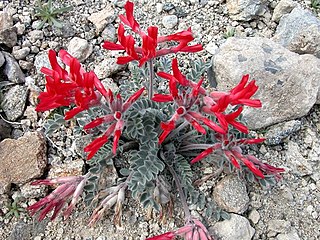
Astragalus coccineus is a species of milkvetch known by the common name scarlet locoweed or scarlet milkvetch. It is native to the deserts, scrub, and chaparral of the Southwestern United States in Arizona, California, and Nevada, and in northwestern Mexico.
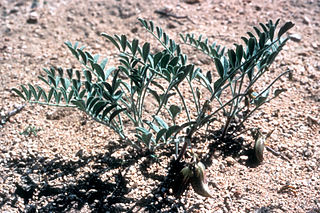
Astragalus ertterae is a rare species of milkvetch known by the common name Walker Pass milkvetch. It is endemic to California, where it is known from only three occurrences near Walker Pass in the Sierra Nevada. It is endangered by trampling, trail use, and also grazing.
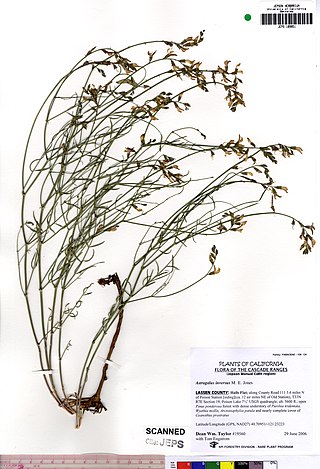
Astragalus inversus is a species of milkvetch known by the common name Susanville milkvetch.

Oxytropis lambertii commonly known as purple locoweed, Colorado locoweed, Lambert's crazy weed, or Lambert’s Locoweed is a species of flowering plant in the legume family.
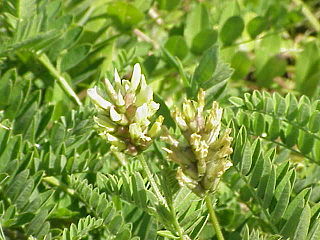
Astragalus cicer, the chickpea milkvetch, chick-pea milk-vetch or cicer milkvetch, is a perennial flowering plant native to Eastern Europe, popularized and subsequently transported to areas in Southern Europe, North America, and South America. It produces pods that resemble those of chickpeas. Its flowers are usually of pale yellow tint, and attract bumble or European honey bees for pollination. Growth often exceeds 0.6 meters, up to a height of 1 meter in length.
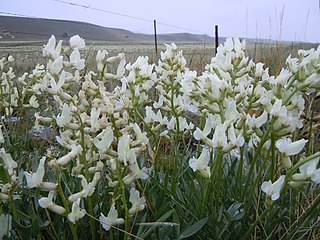
Oxytropis sericea is a species of flowering plant in the legume family known by the common names white locoweed, white point-vetch, whitepoint crazyweed, and silky crazyweed. It is native to western North America from Yukon and British Columbia south through the Pacific Northwest, the Rocky Mountains, and the Great Plains.

Astragalus mollissimus is a perennial plant in the legume family (Fabaceae) found in the Colorado Plateau and Canyonlands region of the southwestern United States.

Smilax lasioneura, the Blue Ridge carrionflower, is a North American species of flowering plants in the greenbriar family. It is widespread across central Canada and the central United States, from Ontario, Manitoba and Saskatchewan south to Texas, Louisiana, and Florida.
Erigeron radicatus is a North American species of flowering plant in the family Asteraceae known by the common names Hooker's fleabane and taproot fleabane The species grows in central Canada and parts of the north-central United States, primarily the northern Rocky Mountains and the Black Hills. It has been found in Idaho, Montana, Utah, Wyoming, Colorado, Nebraska, and South Dakota, with a few isolated populations reported from North Dakota.
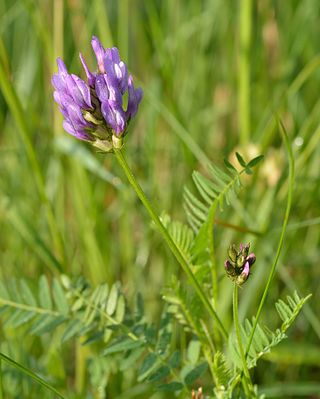
Astragalus danicus, known as purple milk-vetch, is a species of flowering plant in the family Fabaceae (legumes), which is native to Europe.

Astragalus crassicarpus, known as ground plum or buffalo plum, is a perennial species of flowering plant in the legume family, Fabaceae, native to North America. It was described in 1813. The fruit is edible and was used by Native Americans as food and horse medicine. It is a host of afranius duskywing larvae. It is also known as groundplum milkvetch and pomme de prairie.


















